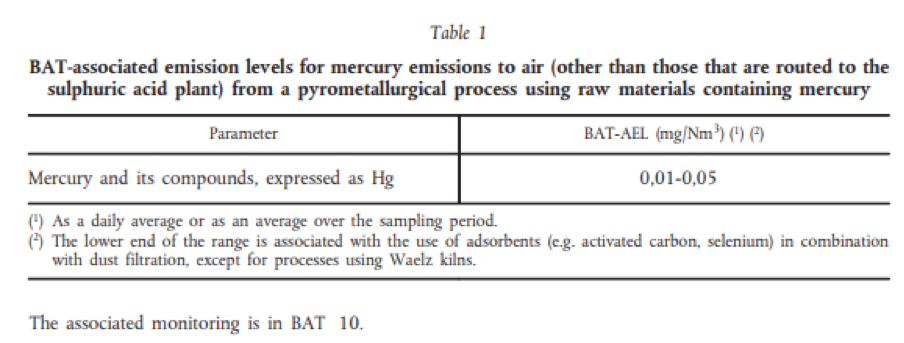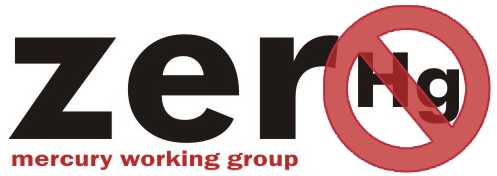During industrial smelting, mercury is produced as a byproduct of processing ore in mining. Usually, metal in extracted from the ore by heating it to a temperature that releases the metal. Since mercury has a lower boiling point than many other metals, the mercury is often released as a gas during the smelting process. Not unless the mercury is captured by special emission reduction equipment, most of it ends up in the atmosphere and aquatic environments, whereas some is deposited onto land. Sometimes the concentration of mercury in some ores is high enough to make recovery for sale economically.
Smelting and roasting processes used in the production of non-ferrous metals
Mining, smelting, and production of iron and non-ferrous metals are also a large source of global mercury emissions to air, and also a very important sector with regard to releases to water. During industrial smelting, mercury is produced as a byproduct of processing ore in mining. Usually, metal in extracted from the ore by heating it to a temperature that releases the metal. Since mercury has a lower boiling point than many other metals, the mercury is often released as a gas during the smelting process. In the mining and processing of metals, most of the mercury is captured and either stockpiled or sold for use in various products, creating anthropogenic sources associated with intentional use.
Nonetheless, the volume of ores and metals involved result in large total emissions and releases. The relatively small volume of primary mercury production makes mercury mining a far smaller source today than it has been in the past (GMA 2013).
Primary production of nonferrous metals (Al, Cu, Pb, Zn) accounts for 10% of the overall mercury emissions to air (GMA 2013)
Relevant legislation and NGO policy work
Globally
The Minamata Convention on Mercury, Article 8 concerns controlling and where feasible, reducing emissions of mercury and mercury compounds, to the atmosphere though measures to control emissions from certain point sources (Annex D) including Smelting and roasting processes used in the production of non-ferrous metals; where “non-ferrous metals” refers to lead, zinc, copper and industrial gold. Different measures are requested for existing and new installations.
Furthermore Guidance on Best Available Techniques and Best environmental practices in relation to emissions from point sources under Annex D of the Minamata conventionhas been finalised at UNEP level and should be considered.
In the EU
Under the EU Mercury Regulation 2017/852, Article 11 referring to Waste mentions that mercury and mercury compounds, whether in pure form or in mixtures, from non-ferrous mining and smelting operations (among others) shall be considered to be waste within the meaning of Directive 2008/98/EC and be disposed of without endangering human health or harming the environment, in accordance with that Directive.
In terms of emissions, the industrial activity of Non-Ferrous Metals is covered under the Integrated Pollution Prevention and Control (IPPC) Directive (96/61/EC).
The IPPC has been in place since 1996. The Commission has undertaken a 2 year review to examine how the legislation on industrial emissions could be improved. As a result, the Commission adopted on 21 December 2007 a Proposal for a Directive on industrial emissions recasting seven existing Directives (the IPPC Directive and six sectoral Directives) into a single legislative instrument. Following the co-decision process Although the principle is the same as for IPPC, the role of the Best Available Technique (BAT) Reference Documents (BREFs) has been strengthened, providing more opportunities to the legislator to question why mercury process may still be permitted in the sector.
IED sets out the main principles for the permitting and control of installations based on an integrated approach and the application of best available techniques (BAT) which are the most effective techniques to achieve a high level of environmental protection, taking into account the costs and benefits. For more information on the directive please visit the EC website.
Through the implementation of the IED, the role of the BREFs has been strengthened. After a BREF is completed, it should be subject to BAT conclusions that are adopted through a comitology decision (implementing act). The right of initiative however rests with the Commission. BAT conclusions contain parts of the BREF, their description, information on applicability, including BAT Associated Emission Levels (BATAELs) for different pollutants (meaning emission levels that can be achieved for a pollutant if the industry is implementing BAT) as well as associated consumption levels and monitoring. It may also include site remediation measures “where appropriate”. Within 4 years after publication of the comitology decision on the relevant BAT conclusions, local authorities should review and update all the permits to the respective industries in order to make sure the industrial activity operates according to the requirements set out in the BAT conclusions.
The provision in the IED requires that Emission Limit Values (ELVs) for pollutants set out in the permit should not exceed the relevant BATAEL. However the permit writer may derogate in specific cases and set higher ELVs under certain conditions. An assessment needs to demonstrate that the application of the BATAEL would lead to disproportionate higher costs compared to the benefits due to the local conditions (technical characteristics of the plants, or geographical location or local environmental conditions).
In any case no significant pollution may be caused and a high level of protection of the environment as a whole is achieved. Environmental Quality Standards also need to be respected. These derogations are subject to public participation and scrutiny by the public concerned, which includes NGOs.
The benchmarks or criteria on which BAT relies are described in the BAT Reference Documents (BREFs). The first Non-Ferrous Metals BREF was adopted in 2001. The BREF was revised in 2016, and BAT Conclusions were adopted on 13 June 2016.

BAT 11. In order to reduce mercury emissions to air (other than those that are routed to the sulphuric acid plant) from a pyrometallurgical process, BAT is to use one or both of the techniques given below

BAT-associated emission levels

